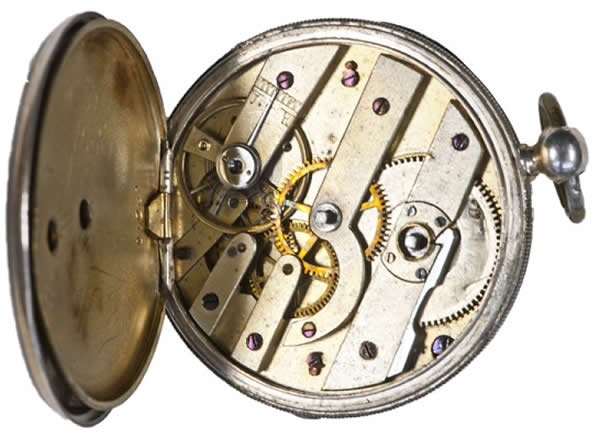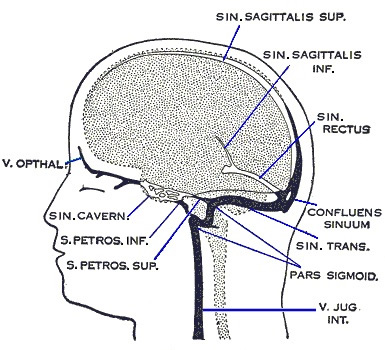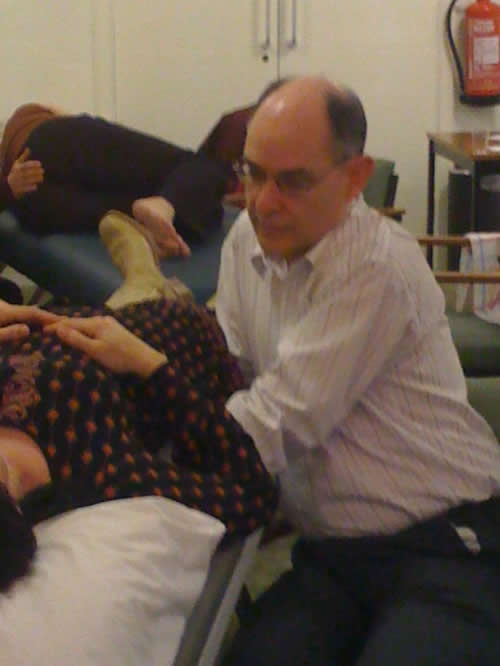Positive Health Online
Your Country

Craniosacral Therapy; Towards a Holistic World View
by Jonathan Lawrence(more info)
listed in craniosacral therapy, originally published in issue 249 - October 2018
When treating patients it is not uncommon when I’m holding the cranium, for the patient to say that they can feel something happening say in the foot or the hip. It is also not unusual for them to report reactions in their digestive system for example. This indicates that the area is treated may in some way be connected to other areas and different systems. This almost always comes across as a surprise.

WatchMaker Analogy - https://en.wikipedia.org/wiki/File:Watch_with_no_background.png
The reason for this is that we live in a culture where our ideas are based on linear thinking. This mode of thought follows the philosophy of Rene Descartes.[1] It is quite normal to model reality on the limited amount we know and in the Cartesian model the world was thought of as analogous to a clockwork mechanism in the same way the brain is often modelled as computer software. The problem is these metaphors are taken literally and confused with ‘reality’.
Thus the universe and world was modelled as a machine. Similarly, the human organism was thought to be a machine and is still treated thus. However, I believe we are in a transition. Having come into contact with alternative viewpoints particularly eastern ideas from India, China and Japan that views the universe as an undivided whole, we have come up with philosophies that move toward or match that of the East.
Alternative medicines that have become popular such as acupuncture and shiatsu have at their core the idea of connectedness. Western alternative therapies such as osteopathy and craniosacral therapy were imagined in the same vein.
At the same time, sciences such as ecology, systems theory and quantum physics are moving the western mind slowly towards acceptance of this paradigm. In my view, this is vital to adapt our worldview in order to confront the issues we face in this time of the unfolding of a man-made ecological disaster, illustrated by declining wildlife and the pollution of the land and oceans.
Nevertheless even those practising osteopathy and craniosacral techniques may be drawn back into a more reductionist approach as the result of cultural influences or the move towards validation criteria, which are rooted in the prevailing paradigm. I have many colleagues who are holistic up to a point but do not appear to have fully understood the principles of holism.
To me, these principles are very simple. A patient comes with a presenting complaint. This complaint not only needs to be evaluated before treatment decisions can be made but also placed in context. That is the key; the context allows us to see all the factors that come into to play. Take low back pain, one of the most common presentations. It is not only important to understand the physiology of the issue but factors such as the person’s age, history, behaviour and affiliations. This can be elucidated partly through case history taking but also through examination techniques.
Craniosacral therapy has another way of doing this that is through palpatory interaction. Palpation consists of feeling the inherent motion in the system. A skilled operator will be able to evaluate the quality of motion of individual structures but also the interactions of structures and systems through the body with the aim of re-establishing balance within the individual structure and between other structures.
These structures may be bones, soft tissues or organs. Patterns of dysfunction may extend over several structures. These structures may be viewed as nested hierarchies[2] within the whole. Each individual structure or higher-level group of structures has its own inherent motion moving around a fulcrum.
This can be illustrated by regarding the whole person whose motion consists of an internal and external rotation. The fulcrum of the total movement is located at the external occipital protuberance and through the sinus rectus where the dural membranes converge. As this occurs a synchronous movement of flexion and extension happens at the spheno-basilar synchondrosis (SBS) between the sphenoid bone and the occiput. Motion of adjacent bones and soft tissues is individual and in synchrony with the rest of the system in health.

Fig. 1 Showing the Sinus Rectus location of the Sutherland Fulcrum
Back to the low back pain example: Say the patient is a female of middle age with pain at the junction between the lumbar spine and sacrum on the left hand side with discomfort radiating to the left buttock. A physiotherapy interpretation may centre on the length of hamstring muscles; a chiropractic interpretation may involve a tilted pelvis. Exercise and manipulation may relieve the symptoms possibly for some considerable time but a recurrence would be extremely likely.

Fig 2 Sacral and Lumbar Contact in Craniosacral Therapy
Say our hypothetical example had a history of slipping on ice as a teenager; in addition, she gave birth 10 years later with a protracted labour aided by epidural anaesthesia. It is quite possible that the craniosacral practitioner would pick up disturbances in the relevant structures. There would be most likely compression in the sacro-coccyx complex quite possibly extending into the lumbar fascia, a distortion of the sacrum related to the birth and the effects of scar tissue indirectly tethering the dural membrane within the lumbar spine, the latter creating a low-grade inflammation.
The craniosacral therapist is able to assess the motion but also discern qualities too, be they compression, shock or even an emotional component. The therapist can estimate the age of an imbalance by how tissues around it may have adapted.
Elements of the assessment are measurable but others are learned through experience by putting factors together such as qualities of palpation with what is known about the history and how patients interact with the process. In such a subjective environment it is vital that the therapist is never dogmatic and that their findings are provisional on new information coming to light. The proof of the pudding is the result; do the treatments resolve the issue permanently or at least point to a course of treatment in which the chronic nature of the issue reduces?
Craniosacral therapy along with other holistic modalities has been characterized as unscientific or even ‘pseudoscientific’. To me the latter term is meaningless and used merely to discredit the object of its use and to close down discussion.
I would contend however that medicine is not scientific, not just because some of the science used to determine treatment is poor,[2] but because each individual has a unique physiology and simply putting patients into generalized diagnostic boxes can only be hit and miss. Therefore the skilled practitioner in orthodox or complementary medicine will individualize treatment. Thus medicine should be characterized as art and science. Evidence-based medicine in principle is fine, but medicine entirely based on evidence is impossible if not potentially dangerous.
Complementary medical practitioners will go further and treat the person and not the disease. This concept is brilliantly articulated by a conventionally trained doctor, Zach Bush[3] in which he contends that there is no such thing as disease but poor communication within the organism. Here he is talking ecologically.
We are made up of 10 trillion or so cells; in addition, we have many times that number of bacterial, viral and fungal cells which are part of our own ecology. Without them, vital nutrients such as Vitamin K[4] and the important neurotransmitter serotonin[5] cannot be produced in useful quantities.
Bush argues that our gut bacteria are similar to bacteria in soils in terms of makeup and function.[6] Soils that are depleted deplete us too. He moves away from recognition of specific disease to a view of illness simply as a state where communication is failing within the organism.
The paradigm shift from mechanistic medicine to a holistic viewpoint is represented not just through craniosacral therapy but also through a gradual convergence and coalition of ideas articulated by practitioners in the orthodox and complementary fields.
This shift will expose the current paradigm to its limitations that in my opinion have contributed to the under-acknowledged explosion in seemingly intractable common chronic, debilitating and life-limiting conditions of the 21 century. Life expectancy is declining in The US and has ground to a halt in the UK.[7]
References
- https://en.wikipedia.org/wiki/Ren%C3%A9_Descartes
- http://www.uwosh.edu/faculty_staff/dilkes/classes/humananat_211/docs/lectures1&2.pdf
- https://www.huffingtonpost.com/dana-ullman/how-scientific-is-modern_b_543158.html?guccounter=1
- https://www.youtube.com/watch?time_continue=8&v=VLKbNEYgBTg
- http://lpi.oregonstate.edu/mic/vitamins/vitamin-K
- https://www.caltech.edu/news/microbes-help-produce-serotonin-gut-46495
- https://www.bbc.co.uk/news/health-40608256
Comments:
-
No Article Comments available